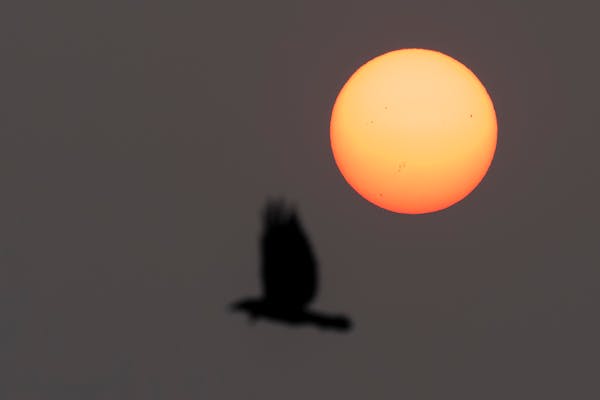An estimated 50 species of songbirds that come to and through Minnesota during spring migration nest in areas of Canada that have burned in recent weeks.
That's my estimate after looking at Canadian fire maps and guide-book maps of breeding territories. Much of that land is boreal forest.
Included are 22 warbler species, 13 sparrow species, plus vireos, thrushes, blackbirds, kinglets, rose-breasted grosbeaks, brown creepers and winter wrens.
Four owl species — great horned, hawk-owl, great gray and boreal — also live in burned or threatened areas, all making occasional irruptions into our state.
An estimated 74% of North America's common loon population and 83% of the great gray owl population breeds within the boreal forest, according to birdnote.org.
Overall, boreal forests are a "bird nursery," with at least 2 billion migratory landbirds, 7 million shorebirds, and 26 million ducks breeding there, according to the Wildlife Conservation Society of Canada.
"Nearly half of all bird species in North America use the boreal forest at some time during the year," the Alberta Environment and Parks agency states on its website.
Significant burning began April 10, according to the Canadian Interagency Forest Fire Centre. The total area burned or burning as of July 5 was more than 21 million acres, according to the Canadian Wildland Fire Information System (cwfis.cfs.nrcan.gc.ca/report).
The usual fire season in Canada extends to the end of October.
Nesting has been threatened since these fires began. Fires could have destroyed appropriate nesting habitat for some species, nests, eggs and nestlings for others. Birds yet to nest could find their preferred habitat destroyed.
The timing of fire related to nesting activity has been on the edge for some species. Black and white warblers, for example, nesting heavily in Canada, arrive at nesting territories in mid-May, according to the book "The National Geographic Complete Birds of North America."
Departure from nesting territories begins in late July, with main migration south in August and September. So, the survival answer for that species is, it depends.
"If a fire encompasses millions of acres, then there are millions of birds impacted," said Jeff Wells, vice president for boreal conservation for National Audubon. "Inevitably, many birds and nests will succumb to the flames."
He added that some species breed later in the season, some starting as late as August, so their nests may not be affected by current fires.
Do nesting birds stay or leave?
"There's a lot of things that go into that calculus of moving versus staying," said Oregon State University ecological physiologist Jamie Cornelius, on a CBC broadcast. She studies how birds adapt to unpredictable environmental changes like fire.
If they choose to move, their options are limited by the huge swaths of land that are currently inhabitable, she said.
Animals that do manage to escape a major forest fire could struggle to survive in their new location, according to Canadian biologist Steeve Côté.
"They're used to a certain habitat. But they'll be new arrivals in an already established ecosystem, and will have to compete for resources," Côté told CBC.
Côté said wildfires typically last days to weeks, but with Quebec's current fires possibly lasting into the summer, it "may take years for the habitat to recover."
Where fire damage is severe, some bird species could find it hard to come by appropriate nesting habitat in spring 2024.
I found no data referring to impact on birds from the ongoing fires. Those studies are yet to be made. Information from studies of previous fires in various habitat types in Canada show much variance by bird species, habitat type and severity of fire. There is no single overall impact on all birds.
Information for this article came from various internet sites, including the Canadian government, provincial governments and Canadian news sources.
Lifelong birder Jim Williams can be reached at woodduck38@gmail.com.
Your winter feeders
Birds from Canada's boreal forest constitute about 17% of land birds counted at feeders in the contiguous United States.
Adapted to fire
Animals, in general, are adapted to wildfires and migrate to safety. But the severity of this year's season could create problems for some species as the amount of overall habitat needed for them to thrive is reduced, said Lisa Venier, a research scientist with the Canadian Forest Service in Sault Ste. Marie, Ontario.
Climate shift
"There's pretty clear evidence at this point that the frequency and the size of the fires have really gotten a lot bigger," says avian ecologist Jeff Wells, Audubon's vice president for boreal conservation. "That's clearly related to climate change."
Forest to savannah
A Canadian forest fire research specialist with Natural Resources Canada co-authored a scientific paper that told the story of a section of forest in the Northwest Territories that burned in 2004 and again in 2010. After the first fire, tree seeds sprouted to begin renewal. The second fire was more intense, burning all organic matter on the ground, including seeds. Replacement growth was grass, "Almost more like a savannah. ... "
C.J. Sansom, bestselling British author of Tudor crime thriller series, dies at 71



